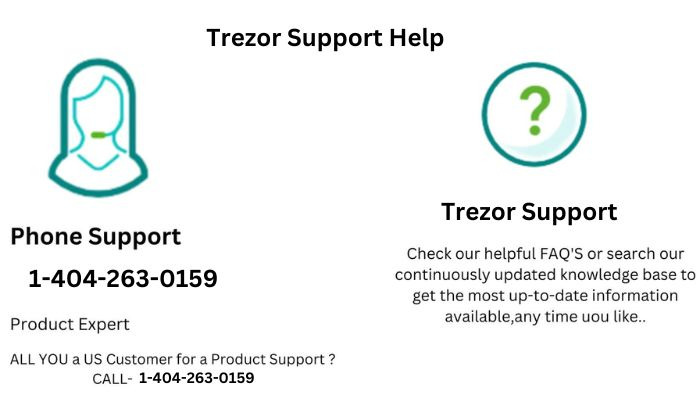The Trezor hardware wallet is one of the most popular and trusted cryptocurrency storage solutions available. Known for its security features, ease of use, and broad compatibility with various cryptocurrencies, Trezor offers users the peace of mind of keeping their private keys offline. However, like any technology, it’s not immune to occasional issues. One of the most common problems that Trezor users face is being unable to sign transactions.
If you're having trouble of Unable to sign transactions with Trezor hardware wallet call at 1-404-263-0159. They will guide you on it.
When a Trezor hardware wallet fails to sign transactions, it can be frustrating and worrying, especially when it involves critical or time-sensitive transfers. Fortunately,
There are several potential reasons for this issue, and more importantly, several ways to resolve it.

Reason Behind Unable to sign transactions with Trezor hardware wallet
1. Outdated Trezor Firmware
One of the first things to check when encountering issues with signing transactions is whether your Trezor's firmware is up to date. Trezor regularly releases firmware updates to fix bugs, enhance security, and improve compatibility with various cryptocurrencies.
How to Check and Update Firmware:
- Connect your Trezor to your computer and access the Trezor web interface (Trezor Wallet or Trezor Suite).
- If a firmware update is available, you’ll see a prompt to update your device. Follow the on-screen instructions to complete the update.
- After updating, check if the issue persists by attempting to sign a transaction again.
Outdated firmware could cause compatibility issues with certain cryptocurrencies or transaction types, and updating it may resolve these problems.
2. Browser Compatibility and Extensions
Another common cause of transaction signing issues is browser compatibility. Trezor wallets communicate with browsers through browser extensions like Trezor Bridge or Trezor Connect. These extensions enable the browser to interact with the hardware wallet.
Troubleshooting Browser Issues:
- Check Browser Compatibility: Ensure that you’re using a supported browser. Trezor generally works best with Chrome and Firefox, but other browsers may have issues.
- Disable Conflicting Extensions: Sometimes, other browser extensions (especially security or privacy-related ones) can interfere with Trezor’s functionality. Try disabling them temporarily and attempt signing a transaction again.
- Clear Cache and Cookies: Sometimes, browser cache or cookies may cause issues with extensions. Clear your browser cache and cookies and then reconnect the Trezor device.
- Install/Update Trezor Extension: Ensure that the Trezor browser extension (such as Trezor Connect) is up to date and installed correctly. You can also reinstall the extension to resolve any issues.
3. Transaction Type or Cryptocurrency Specific Issue
Not all cryptocurrencies are supported equally by Trezor, and specific transaction types (such as multisig transactions or token transfers) may require additional configurations or may not be supported in some cases.
Possible Solutions:
- Check Cryptocurrency Support: Ensure that the cryptocurrency you are trying to sign a transaction for is supported by Trezor. Trezor supports a wide range of digital assets, but some coins or tokens may not be fully supported.
- Verify Transaction Type: For certain advanced transaction types, such as multisig or batch transactions, Trezor may require additional configuration. Verify that you’re following the correct procedure for the specific type of transaction.

4. Connectivity Issues with the Trezor Device
If your device is not properly connected, or if there is an issue with the USB port or cable, you may not be able to sign a transaction. This can happen if the Trezor is not properly detected or is not responding.
How to Fix Connectivity Issues:
- Check USB Cable and Port: Try using a different USB cable or port to ensure that there are no connection issues.
- Restart Trezor and Browser: Disconnect your Trezor, restart the Trezor device and your browser, and reconnect the device.
- Try Another Computer: If the issue persists, test the Trezor hardware wallet with a different computer to rule out issues with the original machine.
5. Trezor’s Memory is Full
In rare cases, the Trezor device may run out of available memory, especially if you store a large number of wallets or use many different cryptocurrencies. This can interfere with the signing process, as the device may be unable to process transactions properly.
How to Free Up Space:
- Delete Unused Wallets: If you have multiple wallets, consider removing unused ones to free up memory.
- Reinitialize Device: If your device is filled with outdated or unnecessary data, consider reinitializing the Trezor device. This will wipe the device, so ensure you have backups of your recovery phrase before proceeding.
6. Incorrect PIN or Passphrase
If the Trezor device is locked and you haven’t entered the correct PIN or passphrase, it will not be able to sign transactions. Ensure that you’ve entered the correct PIN or passphrase to unlock the device.
Troubleshooting:
- Enter Correct PIN: Double-check that you are entering the correct PIN. If you’ve forgotten it, you may need to restore your device from the recovery seed.
- Check Passphrase Settings: If you use a passphrase, ensure it’s entered correctly and matches the passphrase used during wallet setup.

7. Security Software or Firewall Blocking
In some cases, your computer’s security software or firewall may block the connection between the Trezor wallet and your browser. Anti-virus programs or firewalls may mistakenly flag Trezor’s communication process as suspicious.
How to Solve This:
- Disable Security Software Temporarily: Disable your anti-virus or firewall temporarily to see if it resolves the issue. If this fixes the problem, add Trezor’s connection process as an exception in your security software.
- Check for Malware: Ensure that your computer is free of malware that might be interfering with Trezor’s connection.
8. Restore from Recovery Seed
As a last resort, if none of the previous solutions works and you suspect the issue is related to a deeper problem with your device or wallet configuration, you may need to restore your Trezor wallet from your recovery seed.
Steps to Restore:
- On a new Trezor device (or after wiping your current one), choose the option to restore the wallet.
- Enter your 24-word recovery seed.
- This will bring back all your wallets and settings, and you can try signing the transaction again.
Conclusion
While it can be frustrating to encounter issues with signing transactions using your Trezor hardware wallet, most problems can be resolved by troubleshooting one step at a time. Start by ensuring that your firmware is up to date, check your browser and USB connections, and confirm that your device is properly unlocked. If none of these steps work, the issue may be related to a specific transaction type, cryptocurrency, or configuration issue.
https://trezorhelpline.helpshift.com/hc/faq/5-how-do-i-contact-trezor-wallet-support/https://trezorhelpline.helpshift.com/hc/faq/6-what-is-trezor-wallet-support-number-helpline/https://trezorhelpline.helpshift.com/hc/faq/7-how-do-i-contact-ledger-support-phone-number/https://trezorhelpline.helpshift.com/hc/faq/8-how-do-i-contact-to-trezor-support-phone-number/https://trezorhelpline.helpshift.com/hc/faq/9-helpline-what-is-trezor-support-number/https://trezorhelpline.helpshift.com/hc/faq/10-how-do-i-contact-to-live-person-at-trezor-wallet-support/https://trezorhelpline.helpshift.com/hc/faq/11-how-do-i-contact-defi-wallet-support-number/https://trezorhelpline.helpshift.com/hc/en/3-my-app/faq/7-how-do-i-contact-ledger-support-phone-number/
https://robinhoodhelpline.helpshift.com/hc/faq/5-how-do-i-contact-robinhood-customer-support-number/https://trezorhelpline.helpshift.com/hc/faq/12-how-to-get-in-touch-with-defi-wallet-support-24---7/https://trezorhelpline.helpshift.com/hc/faq/13-helpdesk-trezor-customer-service-phone-number/https://robinhoodhelpline.helpshift.com/hc/faq/6-live-how-do-i-contact-to-real-person-at-robinhood-support/
If you're still having trouble, reaching out to Trezor support or consulting the Trezor community forums for more specific guidance is always a good option. Your Trezor wallet is a powerful tool for keeping your cryptocurrency safe, and resolving these issues will help ensure that it continues to function securely and reliably.
